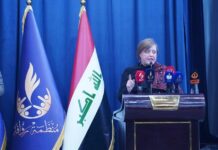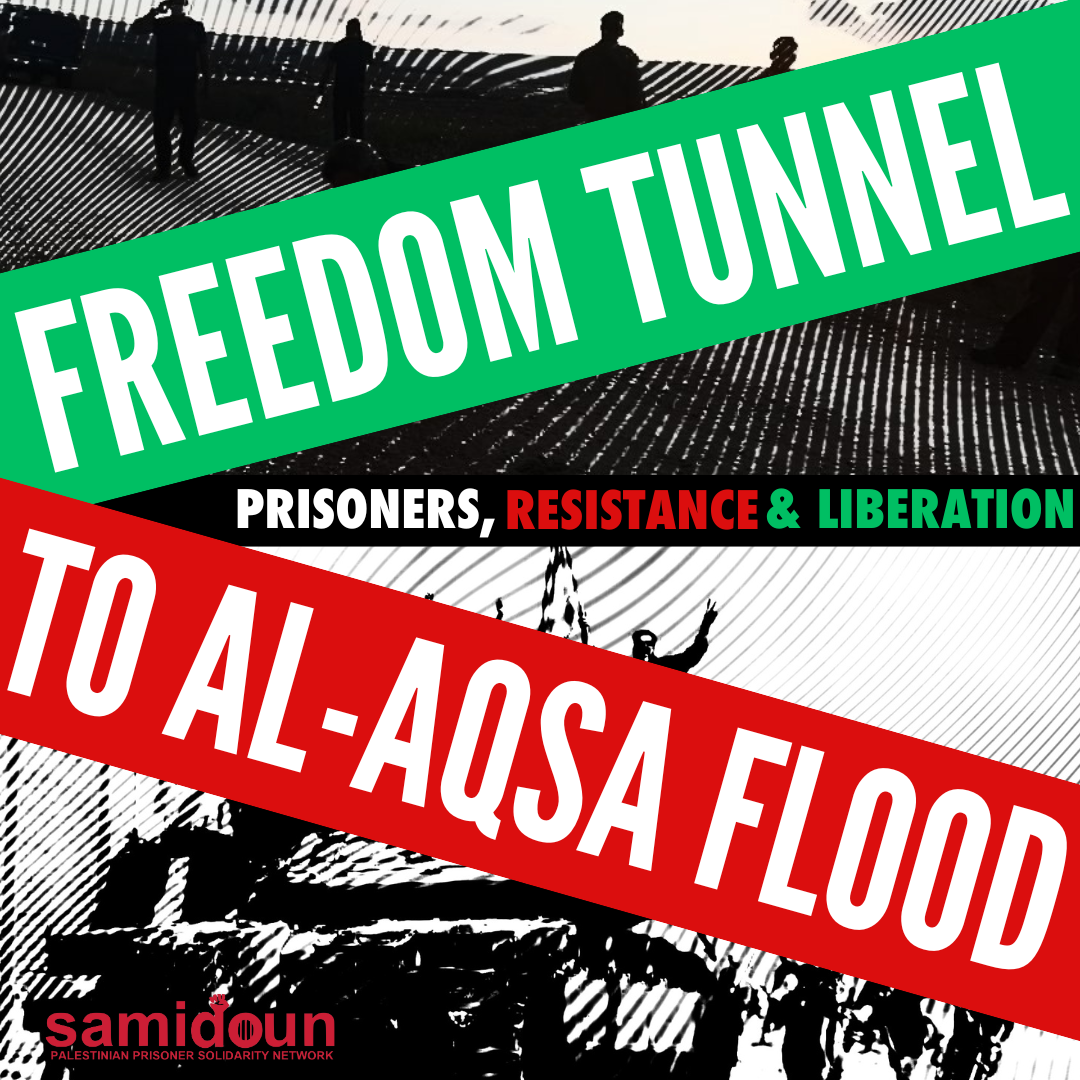
On 6 September 2024, we mark the third anniversary of the great Freedom Tunnel on 6 September 2021, in which six Palestinian prisoners – Mahmoud al-Ardah, Mohammed al-Ardah, Yousef Qadri, Ayham Kamamji, Munadil Nafa’at and Zakaria Zubeidi — liberated themselves from the Zionist occupation regime’s “high security” Gilboa prison. The Freedom Tunnel was a harbinger of the Al-Aqsa Flood, exposing the illusory nature of the occupation’s proclaimed technological and intelligence superiority and inspiring collective hope and optimism in Palestine and around the world about the future of the Palestinian cause.
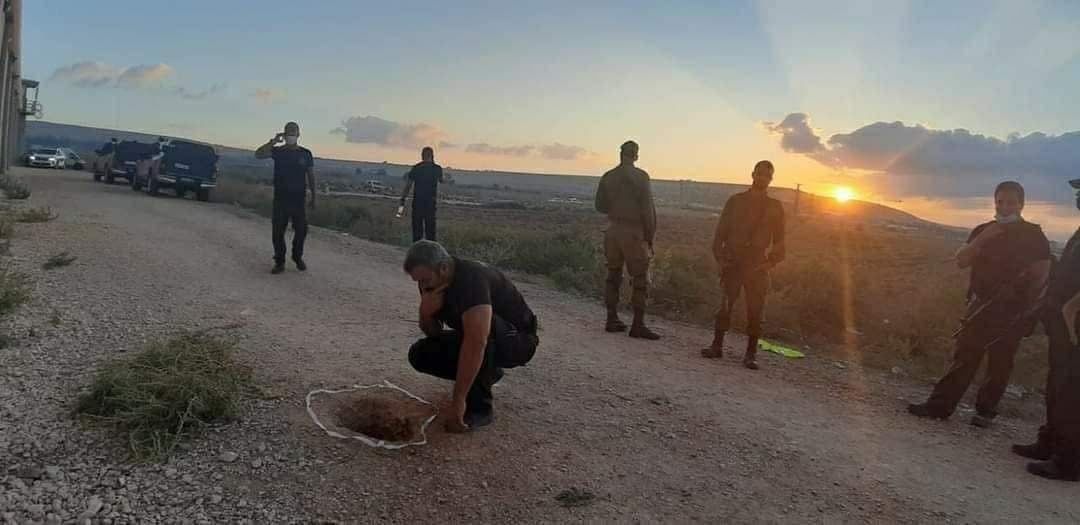
The heroic Al-Aqsa Flood, launched on 7 October 2023, has exposed the inhuman rampage of the genocidal enemy and its imperialist backers – the US, Germany, France, Britain, Canada and more – and highlighted to all the legendary courage, strategic planning and execution, steadfastness and brilliance of the armed Resistance. At a time when the bombing of refugee camps, the destruction of hospitals, and the slaughter of mangled children have become daily news updates that could provoke despair in all who love life and cherish humanity, it is the ingenuity, resourcefulness, faith and deep dedication of the resistance, its leaders and its fighters, from the depths of the tunnels of Gaza to the paragliders soaring over the colonial fences, that continues to spark not only hope but certainty of victory and empower a growing global Intifada.
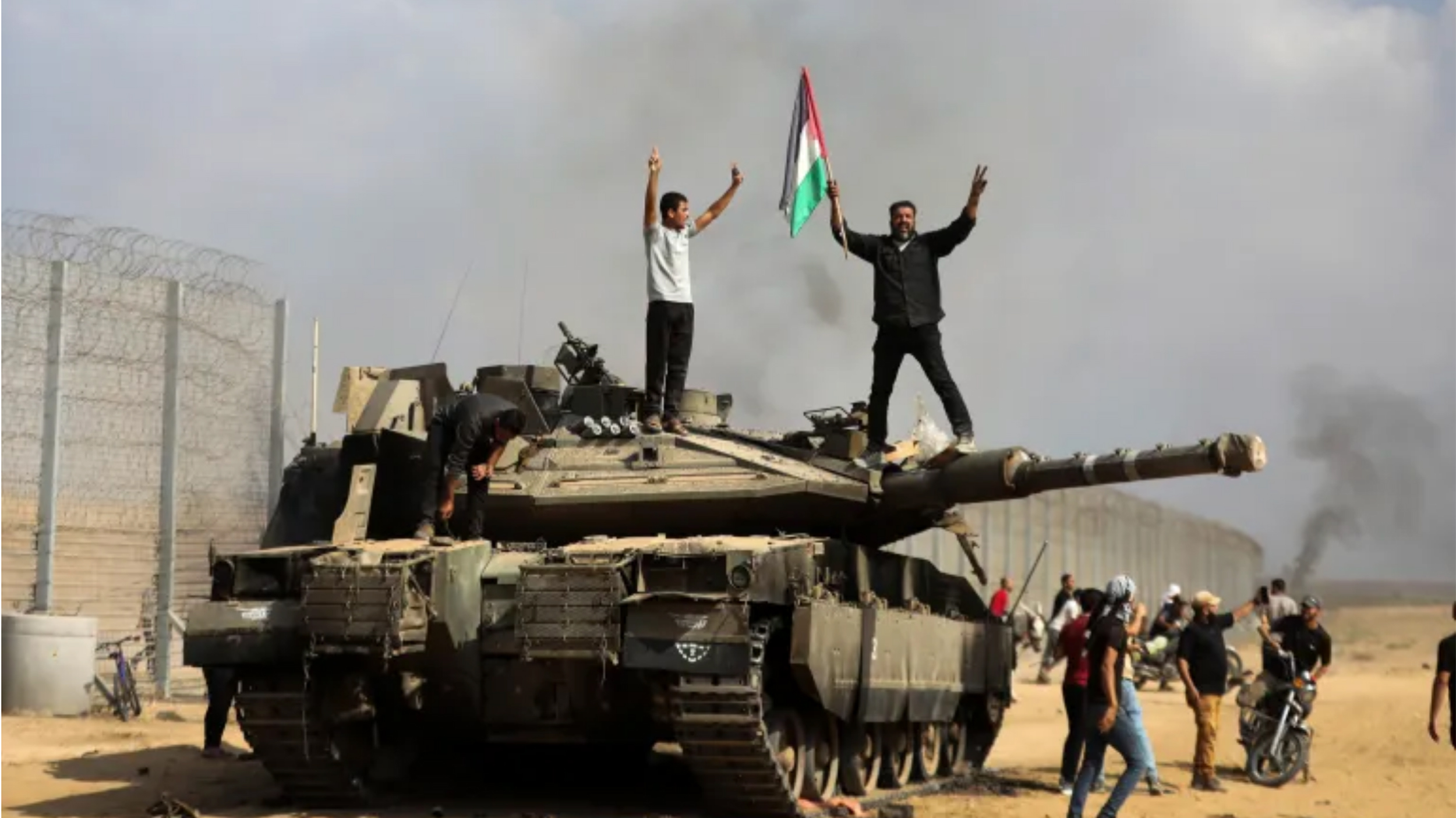
This anniversary takes on additional significance and profundity in light of the current moment – Al-Aqsa Flood is characterized not only by the heroic Resistance, and most centrally the armed resistance, and the Zionist genocide in Gaza, but by the invasions throughout the West Bank of occupied Palestine, particularly in Jenin (the home of the Freedom Tunnel heroes), Tulkarem and Tubas. On 4 September, Zakaria Zubaidi’s son, Mohammed, was martyred alongside his comrades from both Jenin and Tubas after they were targeted for assassination, as Zionist occupation forces fired three missiles at their car.

Mohammed Zakaria Zubaidi
Mohammed Zakaria Zubaidi was martyred alongside four fellow resistance fighters and leaders from both Jenin and Tubas – Mohammed Nazmi Abu Zagha, Mohammed Awad Abu Jumaa, Qusai Majdi Abdullah Abdelrazeq, Ahmed Fawaz Abu Dawas, as well as the youth Majed Abu Zeina.
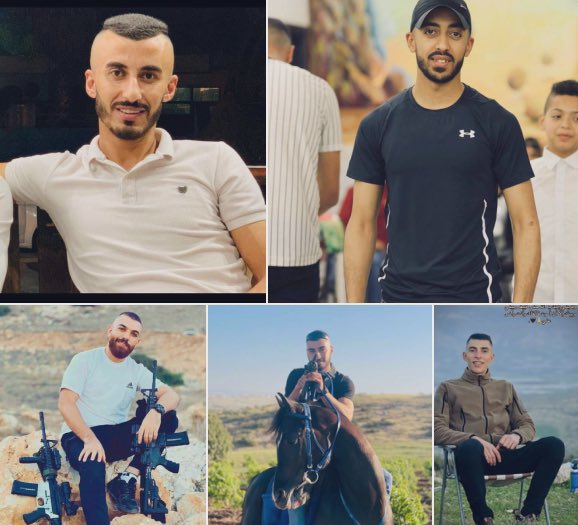
Mohammed Zubaidi survived an assassination attempt in Jenin just days before; growing up in Jenin refugee camp, forcibly separated from his imprisoned father for much of his life, he rose in the resistance to become a leader in his own right. The Zubaidi family has given martyr after martyr for Palestinian liberation, alongside the people of Jenin camp and city, a beating heart of resistance that has never been extinguished by either British or Zionist colonialism.
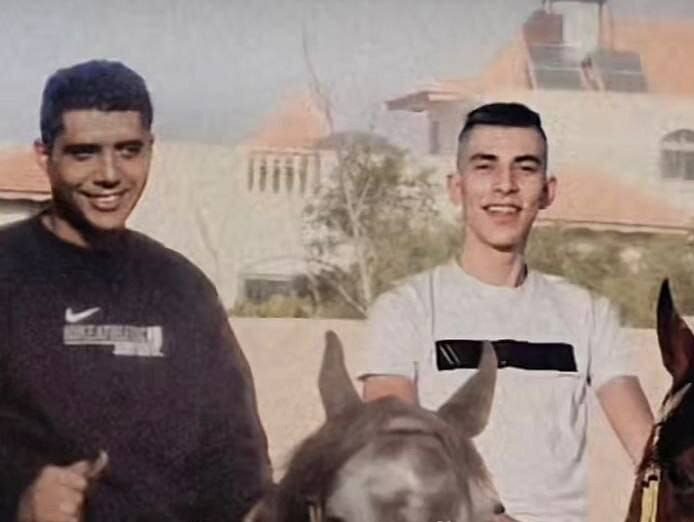
The history, present and future of the resistance in Jenin was woven into the Freedom Tunnel operation, a legacy that has continued in the Jenin Brigades, through its brave fighters and heroic martyrs who have relentlessly fought to free Jenin – and all of Palestine – from the grasp of the occupation. Despite the destruction wrought by the occupation forces – including tearing up 70% of Jenin’s roads – and the precious martyrs taken by their assaults and assassinations, from Mohammed Zubaidi and his comrades to Abu Shujaa in Tulkarem, the Resistance throughout the West Bank continues to fight, to rebuild, to defend their land and people, and to advance the cause of liberation.
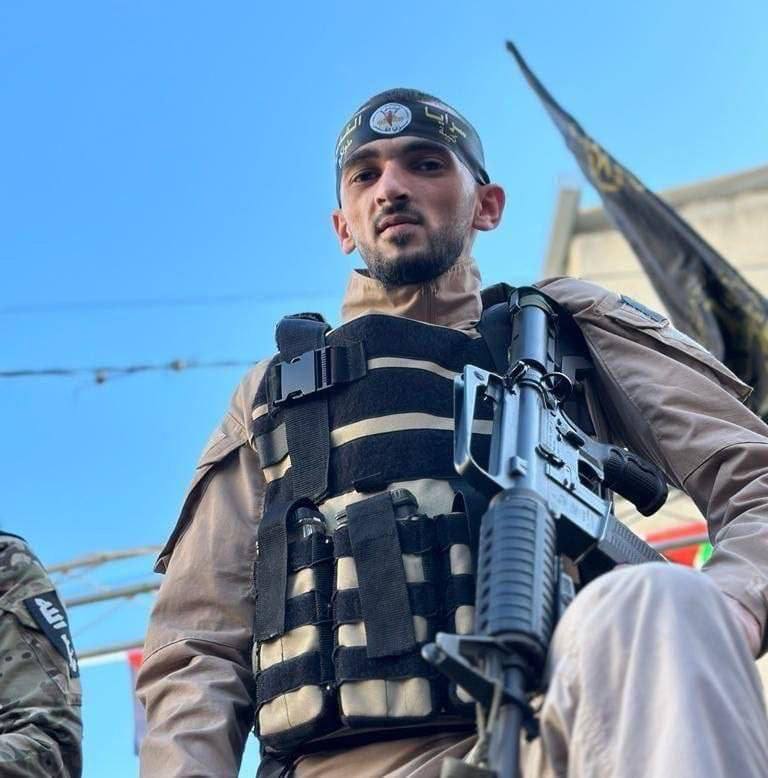
The great popular Intifada of 1987 launched from Gaza in December, six months after the May 1987 Gaza prison break of Misbah al-Suri and his comrades and two months after their battle in Shujaiyya with occupation forces on 6 October, now commemorated as the official anniversary date of the founding of the Palestinian Islamic Jihad Movement; and of course, two years after the great prisoner exchange of 1985 conducted by the Popular Front for the Liberation of Palestine – General Command which liberated 1150 Palestinian prisoners, including al-Suri, Kozo Okamoto of the Japanese Red Army; Sheikh Ahmad Yassin, later the spiritual leader of Hamas; and Ziyad Nakhaleh, the current general secretary of Palestinian Islamic Jihad.
Similarly, it is clear that alongside the Battle of Seif al-Quds/the Unity Intifada, the Freedom Tunnel – and, of course, the Wafa’ al-Ahrar prisoner exchange accomplished by the Resistance in 2011 in which many leaders, including most prominently, Yahya Sinwar, chair of the Political Bureau of Hamas, were liberated – is one of the immediate forebears of 7 October 2023.
The light of liberation that shone from the Freedom Tunnel has become a burning sun of the Palestinian revolution, casting away all illusions and exposing the friends and enemies of the Palestinian people, unquenchable until victory and liberation, from the river to the sea. It is clear to all that the Palestinian resistance – alongside the resistance forces in the region, stretching from Lebanon to Yemen to Iraq to Syria to Iran, and around the world, from the Sahel to Venezuela, with the support of our movements on our campuses, communities, countries and cities everywhere, including in the heart of the imperial core – can and will defeat the Zionist project in Palestine and US-led imperialism in the region, no matter how vicious their genocidal aggression and the irreplaceable human toll that they are determined to extract from the Palestinian and Arab people.
Today, the six heroes of the Freedom Tunnel are high priorities for liberation in a prisoner exchange conducted by the Resistance, alongside their fellow leaders of the prisoners’ movement: Marwan Barghouti, Ahmad Sa’adat, Abdullah Barghouti, Abbas al-Sayyed, Ibrahim Hamed, Hassan Salameh, Nael Barghouti, and their fellow prisoners with lengthy sentences, alongside the steadfast women prisoners like Khalida Jarrar, Hanan Barghouti, Bushra al-Tawil, Shatila Abu Ayad, and all of the thousands of Palestinian prisoners held behind Zionist, imperialist and collaborationist reactionary regime bars.
The situation inside the prisons has become even worse for Palestinian prisoners, as the Zionist regime carries out a deliberate policy of torture, starvation, medical neglect and abuse. For thousands of Palestinians abducted from Gaza and held in the torture camps like Sde Teiman, Zionist imprisonment has meant extreme physical and psychological torture, rape and sexual assault, conducted as a matter of state policy. The internal Zionist front is being torn apart with contradictions, especially after the exposure of the Netanyahu government’s willingness to give up the Zionist captives held by the Resistance in order to prolong their political future – even at the expense of the Zionist project itself.
This year, as we recall the Freedom Tunnel, we are republishing our analysis (slightly edited) issued on the anniversary of the Freedom Tunnel, below. Samidoun Palestinian Prisoner Solidarity Network urges all in the movement to take this anniversary as an occasion to highlight the struggles of the Palestinian prisoners’ movement as part and parcel of the Palestinian liberation struggle, demand an end to the genocide, the freedom of the Palestinian prisoners and the liberation of all of Palestine, and to celebrate and honour the heroic resistance of the Palestinian people, especially the armed resistance at the forefront of that liberation.
Glory to the martyrs, freedom for the prisoners, and liberation for Palestine, from the river to the sea.
The Freedom Tunnel: Palestinian prisoners leading the resistance
- Historic Palestinian prisoner escapes
- Inside prisons: confronting the occupier
- The Freedom Tunnel and the resistance
- Internationalism and the Freedom Tunnel
- The Freedom Tunnel Prisoners
- Samidoun statements on the Freedom Tunnel
Today, 6 September, marks the anniversary of the Freedom Tunnel, when six Palestinian prisoners liberated themselves in 2021 from the high-security Gilboa prison of the Israeli occupation. The six Palestinians — Mahmoud al-Ardah, Mohammed al-Ardah, Yousef Qadri, Ayham Kamamji, Munadil Nafa’at and Zakaria Zubaidi — became national and international symbols of resistance and of the Palestinian will to freedom in seemingly impossible circumstances, while the simple spoon became a new icon of the resistance and steadfastness of the Palestinian people and their resistance leaders behind bars. While the six were eventually re-captured, their daring, well-organized escape from Gilboa exposed the weakness and cracks hiding beneath the propaganda exterior of “impenetrable Israeli security,” throwing the occupation prison system into internal crisis.
Five more Palestinian prisoners — Iyad Jaradat, Mahmoud Abu Shreim, Ali Abu Bakr, Mohammed Abu Bakr and Qusay Mar’i — are also imprisoned for their role in supporting the Freedom Tunnel actions. The six Freedom Tunnel prisoners and the five who supported them are held in solitary confinement and isolation, in a fruitless attempt to prevent their actions from remaining a bright example to the Palestinian prisoners’ movement and the Palestinian people.
Coming as it did so soon after the battle of Seif al-Quds/the Unity Intifada, the Freedom Tunnel captured the imaginations and consciences of the Palestinian people and Arab nation but also of all around the world who struggle for justice and liberation. Despite decades spent behind bars, the occupation was unable to break the will of the Palestinian prisoners or their leadership in resistance, and the six heroes of the Freedom Tunnel have once again demonstrated this clearly to the world.
Palestinian Prisoner Escapes
The Freedom Tunnel built on a long history of Palestinian prisoners’ resistance actions, from hunger strikes to collective rebellions behind bars, as well as successful escapes and self-liberations from occupation prisons. Some of the major escapes in Palestinian history include:
- Atlit prison, 1938 – One of the leaders of the 1936-1939 revolt in Palestine against British colonialism, who fought alongside Sheikh Izzedine al-Qassam, Issa Hajj Suleiman al-Battat, escaped with several other Palestinian prisoners jailed by the British in 1938 before
- Shata prison, 1958 – Many estimate this was the largest prison uprising and escape since the Nakba. Approximately 190 Palestinian and Arab prisoners revolted inside the Shata prison in the Jordan Valley on 31 July 1958. 77 prisoners escaped after fierce fighting in which 11 prisoners and two jailers were killed. Mohammed Jahjah, Zakaria Zubaidi’s grandfather, was one of the prisoners who liberated himself in this rebellion, who then participated in leading the fedayeen in armed struggle in Irbid, Jordan, before moving with the fighters to Syria.
- Hamza Younes prison escapes, 1964, 1967 and 1971 – Palestinian prisoner Hamza Younes, from Ara, south of Haifa, escaped from occupation prisons on three occasions: from Asqelan prison, from a hospital and a third time from Ramle prison. In 1971, he escaped to Lebanon where he joined the Palestinian resistance there.
- Ramallah prison, 1969 – Mahmoud Abdullah Hammad from Silwad, near Ramallah, escaped during a prisoner transfer in 1969. He evaded occupation forces for nine months and successfully made it to Jordan.
- Nasser Issa Hamed and Majdi Suleiman Abu al-Safa, 1983 – Nasser was 15 years old at the time and was taken to the occupation court on 27 January 1983. The prisoners launched a confrontation inside the court and Nasser escaped into Ramallah, where he took shelter in an unfinished construction project. He hid in a well as he attempted to make his way home to Silwad, but eventually turned himself in after his mother was arrested by the occupation forces. One month later, learning of the story, Majdi Suleiman Abu al-Safa escaped in the same way from the occupation courts, making his way to Jordan and then to Colombia and Brazil, where he has remained until the present day.
- Gaza prison, 1987 – Six Palestinian prisoners escaped Gaza prison on 17 May 1987; three were later assassinated by occupation forces and one more was re-imprisoned. Imad Saftawi and Khaled Saleh fled the Gaza Strip and maintained their freedom.
- Nafha prison, 1987 – Three Palestinian prisoners, Khaled al-Rai, Shawqi Abu Nasir and Kamal Abdel-Nabi escaped Nafha prison successfully in 1987 but were recaptured eight days later as they attempted to make their way to Egypt.
- Omar Nayef Zayed’s prison escape, 1990 – On 21 May 1990, Omar Nayef Zayed escaped from occupation prisons four years after his arrest as he was transferred to a hospital in Bethlehem. He made his way to Jordan and then to Bulgaria in 1994. In 2016, occupation forces attempted to have him extradited from Bulgaria to occupied Palestine, and he took refuge inside the Palestinian Authority embassy where he was later killed on 26 February 2016. His fight against extradition sparked an international campaign to support him and demand his freedom.
- Escape of Saleh Tahaineh, 1996 – Saleh Tahaineh escaped from Ofer prison in a complicated plan involving his fellow struggler Nu’man Tahaineh — later also assassinated by the occupation — and another Palestinian prisoner scheduled to be released. He took the place of the prisoner whose release was scheduled, who then noted that he had not been released. He had earlier switched places with Nu’man, who had a much lower sentence. He was pursued and eventually killed by occupation forces after being captured. Both Saleh and Nu’man Tahaineh were mentors of Mahmoud and Mohammed al-Ardah.
- Kfar Yona prison, 1996 – Two Palestinian prisoners, Ghassan Mahdawi and Tawfiq al-Zaben, escaped through a tunnel in 1996, the first prisoner escape that made use of a tunnel. While Mahdawi was seized the next year, al-Zaben was pursued by the occupiers for four more years.
- Ofer prison, 2003 – Four Palestinian prisoners escaped from Ofer prison in 2002 during the Al-Aqsa Intifada, including Palestinian student Amjad al-Deek, using spoons and other implements to tunnel their way outside the prison. Three were later recaptured while Riyad Khalifa was killed by occupation forces.
- Freedom Tunnel, 2021 – Six Palestinian prisoners escaped from Gilboa prison after digging a tunnel beneath the prison. While they were eventually recaptured, their bravery and commitment inspired Palestinians, Arabs and people around the world, especially in an era of advanced technological surveillance.
- Multiple escape attempts – Over the years, Palestinian prisoners, including Mahmoud al-Ardah, who led the Freedom Tunnel operation, attempted to escape, including digging lengthy tunnels before being blocked. These included prisoners in Shata prison in 1998, Asqelan prison in 1996, Gilboa prison in 2014, and Eshel prison.
Inside the Prisons: Confronting the Occupier
The Freedom Tunnel action not only captured the imagination of Palestinians, Arabs and internationals seeking justice, in an era in which such actions had come to seem nearly impossible due to the high level of technological and electronic surveillance, it also sparked a crisis for the occupation. It exposed the weaknesses and failures in the system of military occupation that could not be protected by technology alone and remained highly vulnerable to the human element of the drive for freedom.
Since the Freedom Tunnel, the occupation has deployed large sums of money and resources to “enhance security” in the prisons, especially as they completed their self-liberation from Gilboa Prison Section 5, which had been constructed in 2004 and was touted as “invulnerable” to escape attempts. Over a period of time, the six prisoners dug the tunnel to the outside below the toilet area. They proceeded through the tunnel at approximately 1:49 am, and they were discovered not by an alert within the prison but by a settler who reported the presence of a “suspicious person” nearby. Images of occupation soldiers staring at the hole in the ground left by the tunnel and puzzling over the prisoners’ route were widely distributed.
The prison administration immediately began to implement measures against the prisoners following their public security humiliation. When the six heroes of the Freedom Tunnel were re-arrested, they were thrown in solitary confinement in difficult conditions, not provided medical care for their obvious injuries from beating and torture upon arrest, and transferred from prison to prison. However, they were not alone; the prisoners’ movement inside the prisons rose up, taking protest actions and burning cells to demand the rights of the Freedom Tunnel heroes. Outside, the Palestinian resistance announced that the six Freedom Tunnel prisoners would be at the top of the list for any upcoming prisoner exchange agreement.
Prison officials imposed a lockdown on many prisoners, particularly those of the Islamic Jihad movement and all prisoners with high or life sentences. Five of the six Freedom Tunnel prisoners are part of the Palestinian Islamic Jihad movement, while the sixth, Zakaria al-Zubaidi, is a longtime Fateh leader; all six are from Jenin. The occupation authorities attempted to impose transfers every six months on those with high sentences, engaged in mass transfers of the Islamic Jihad prisoners, blocked family visits and engaged in ongoing raids, invasions and aggressive searches throughout the prisons.
In March 2022, the united Palestinian prisoners’ movement escalated toward a collective open hunger strike to stop such measures from going into effect, and the occupation was forced to back down. When it attempted to do the same again in August 2022, the prisoners’ movement again planned for an open hunger strike to begin on 1 September 2022, which was again averted as the occupation backed down. Further, the Islamic Jihad prisoners also achieved an end to the ongoing transfers of their prisoners and to return the prisoners to the sections from which they were originally transferred, while two prisoners, Abdullah al-Ardah and Abed Obaid, were returned to the general prison population from isolation.
In May 2022, the six heroes of the Freedom Tunnel were sentenced to five additional years of imprisonment, while five more Palestinians — Mohammed Abu Bakr, Iyad Jaradat, Ali Abu Bakr, Mahmoud Abu Shreim and Qusai Mar’i — were sentenced to four years for assisting their fellow prisoners.
In response to the sentences, Yaqoub Qadri affirmed: “We do not care what the sentence is. The important thing is that we made the impossible possible; we were able to break through the Israeli security services and dealt a blow. We were able to achieve something that was unthinkable for Israel and its security mechanisms.”
Even the judge in the court essentially affirmed Qadri’s comments that the sentence is a form of revenge for exposing the fragility of colonial domination in Palestine, noting that their self-liberation, “paralyzed the nation for days” and caused large financial expenditures, imposing additional costs on the occupation.
The response to repression following the Freedom Tunnel has been increased resistance inside the prisons, strong unity between all Palestinian political forces and a continued promise of freedom that no amount of repression has been able to suppress.
The Freedom Tunnel and The Resistance
Estimates indicate that the occupation spent tens of millions of dollars in less than 12 days in their pursuit of the Freedom Tunnel heroes. They further launched a project to fortify the prisons at a cost of $2.5 million. Thousands of police and army forces participated in the searches, with 720 police patrols, dozens of military vehicles and 250 checkpoints set up in the panicked reaction to the self-liberation of these Palestinian prisoners.
The effect of this action on the occupier and the self-liberation of these six Palestinians from Jenin has continued to inspire and inflame the growing resistance in Jenin, which has been the site of harsh battles as occupation forces attempt to suppress the resistance. Many referred to the Freedom Tunnel heroes as the Jenin Brigade, the name taken up by the fighters resisting the occupation in Jenin and heroically fighting back a massive invasion in July 2023.
The Freedom Tunnel came only months after the Seif al-Quds Battle/Unity Intifada throughout Palestine and served to confirm once again that the prisoners are at the heart of the resistance and are a truly unifying factor for the Palestinian people and the Palestinian cause. The Palestinian resistance upheld the centrality of the prisoners in the defense of Gaza in the Unity of the Fields battle of August 2022 and again in the Revenge of The Free of May 2023, amidst massacres by the occupation and through the placement of the Freedom Tunnel prisoners at the top of the list for an exchange agreement. Today, amid the Battle of Al-Aqsa Flood, the prisoners are once again at the core of the liberation movement, a compass toward freedom, resisting the genocidal onslaught alongside their people throughout Palestine.
Internationalism and the Freedom Tunnel
The message of the Freedom Tunnel was not confined to occupied Palestine nor even to Palestinians in exile and diaspora around the world. In protests and demonstrations in many international cities, the symbol of the spoon and the images of the Freedom Tunnel heroes inspired people to take to the streets to demand justice and liberation for Palestine and the Palestinian prisoners and an end to Western imperialist complicity with and support for occupation crimes.
From the Philippines to Colombia to France, where Georges Abdallah has been jailed for 40 years, the message of the Freedom Tunnel resonated among political prisoners and those fighting for their liberation. It proved the indomitable will of revolutionary prisoners and of the Palestinian people in seeking freedom in the most unfavorable circumstances, inspiring many to mobilize and join the movement to liberate Palestinian prisoners — and Palestine itself, from the river to the sea.
The Freedom Tunnel and the six heroes of the self-liberation operation represent the irrepressible hope of freedom and commitment to liberation that no amount of militarized repression and Zionist colonization has suppressed, for over 75 years. The actions of this “Freedom Brigade” are not only a symbol of hope for Palestinians but also for everyone in the world who seeks justice and freedom.
Building on the experiences of Palestinian prisoners who liberated themselves in the past, they exposed the crumbling edifices of the Israeli occupation and forced them to waste tens of millions of dollars in their massive manhunt. Their bravery and commitment to freedom is celebrated throughout Palestine, from the river to the sea, and everywhere around the world. Spoons – symbols of the rusty kitchen tools they used to dig their way to liberation – have come to represent the irrepressible drive to freedom.
Al-Aqsa Flood changed the world, building upon the history of the Palestinian revolution — including that of the Freedom Tunnel. As we build the global intifada and develop our movement to confront the Zionist genocide and support the Resistance and the liberation struggle, Samidoun Palestinian Prisoner Solidarity Network urges all to stand with the Palestinian prisoners’ movement and the Palestinian people to demand justice and liberation for Palestine, from the river to the sea.
The Freedom Tunnel prisoners
Mahmoud al-Ardah

Mahmoud Abdullah al-Ardah, the leader of the Freedom Tunnel escape, was born on 8 November 1975 and grew up in Arraba, Jenin. He first became active as a boy during the great popular intifada of 1987 and was seized and imprisoned for the first time in 1992 on allegations of targeting occupation jeeps and military patrols with Molotov cocktails. He became a part of the Palestinian Islamic Jihad movement in prison before his release in 1996. Eight months later he was arrested again by the occupation forces for shooting a military officer invading Salfit and harbouring the martyr leader Saleh Tahaineh, who had himself escaped from occupation prisons. He was already sentenced to 99 years in occupation prisons before the Freedom Tunnel operation.

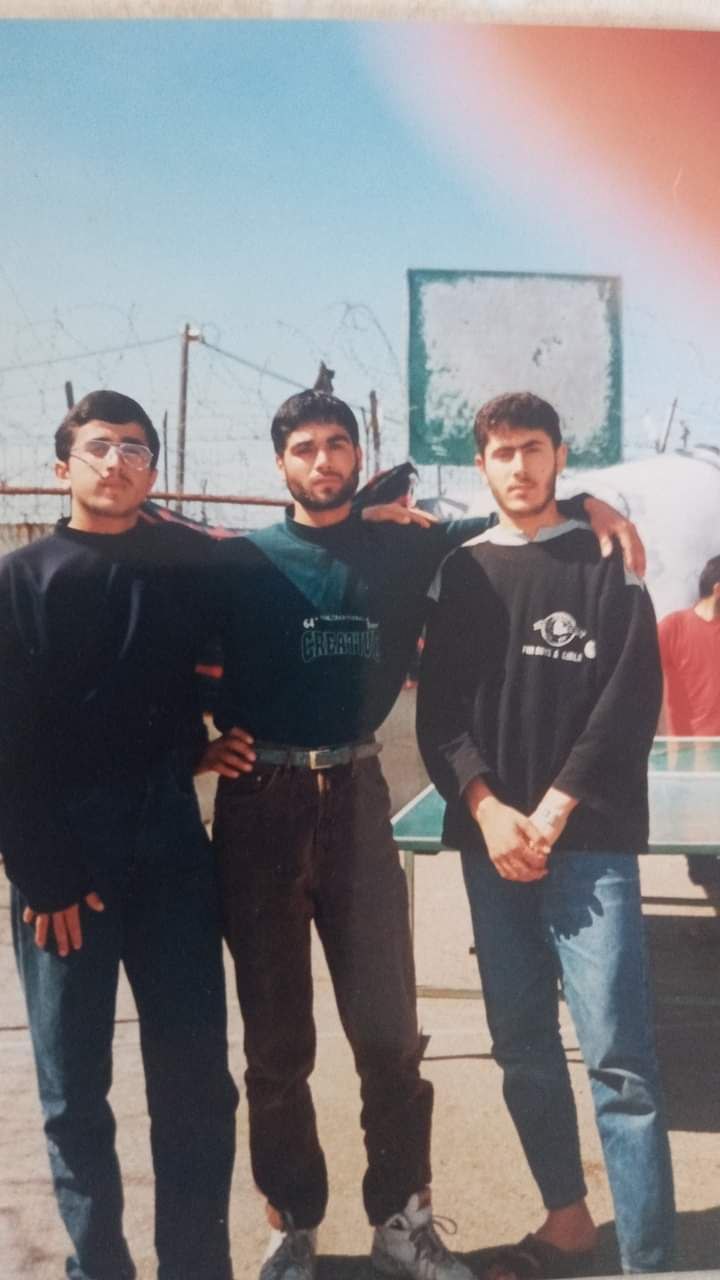
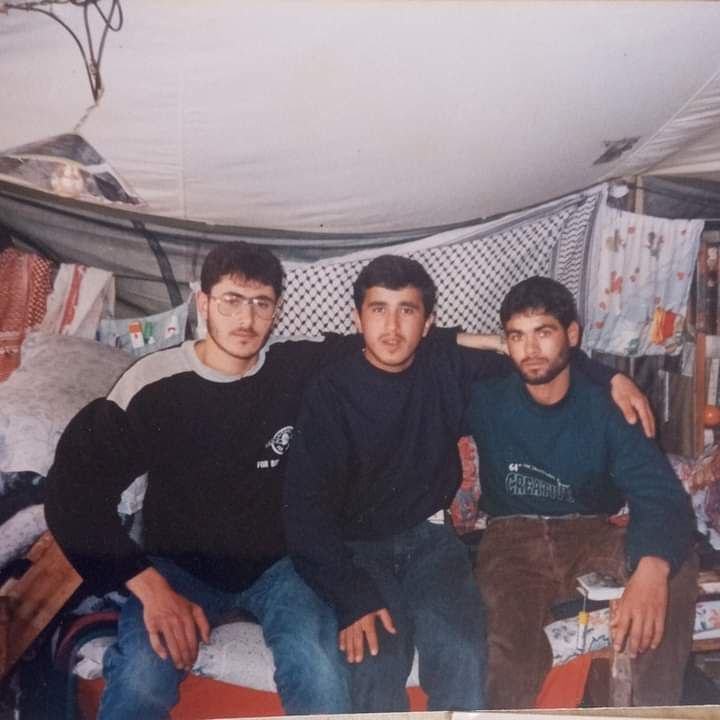
Photos of Mahmoud al-Ardah from 1997 in Megiddo prison (above)
After his imprisonment, he attempted to escape on multiple occasions, in 2001, 2011 and 2014. In the latter instance, he was accused of digging a tunnel to escape from Shata prison and on each occasion he was placed in isolation. He obtained both his high school diploma and bachelor’s degree in prison and became a leader of the prisoners’ movement before designing and planning the Freedom Tunnel self-liberation.
Mohammed al-Ardah

Mohammed Qasem al-Ardah, is 39 years old, from Arraba, Jenin. He has been imprisoned since 14 May 2002 and is sentenced to 3 life sentences and 20 years (now 25 years) in occupation prisons for his role in the military resistance to occupation, particularly during the Al-Aqsa Intifada. He is a struggler with the Palestinian Islamic Jihad movement. His brother, Ahmad, said that Mohammed was like a second father to their family after the death of their own father. He became the imam of the mosque in the area and a beloved, respected figure in Arraba. Like Mahmoud al-Ardah, Mohammed al-Ardah knew Nu’man Tahaineh, involved with Saleh Tahaineh in his escape, closely, as well as fellow escapees Iyad Sawalha and Iyad al-Hamran, both of which were involved in the 2002 escape from Ofer prison.
Yaqoub Qadri

Yaqoub Mahmoud Qadri (Ghawadra) was born on 22 December 1972 in Bir al-Basha, Jenin, growing up in Bir al-Basha and neighboring Arraba. As a teen, he was active in the great popular intifada of 1987. Seized by the occupation forces, he became more active following his imprisonment. He was later detained by the Palestinian Authority in 1996 under its “security coordination” with the Israeli occupation, and with the Al-Aqsa Intifada, became active in the resistance with the Palestinian Islamic Jihad Movement, fighting to defend his village and neighboring villages and refugee camps from invasions by occupation soldiers.
He participated in the battle to defend Jenin camp in 2002 when it was subjected to massacres by occupation forces, and in operations targeting illegal settlers stealing Palestinian land. He was “wanted” and pursued by the occupation for over a year before he was seized in October 2003 in a cave near Zababdeh. He was sentenced to two life sentences and 35 years after spending four months under severe torture in interrogation in Jalameh interrogation center. He joined Mahmoud al-Ardah in the attempt to escape Shata prison in 2014 before once again joining in the Freedom Tunnel escape. He described the days of his self-liberation as the most beautiful of his life.
Munadil Nafa’at

Munadil Naf’at, 26, is one of four brothers from Ya’bad, Jenin. His family is heavily involved in the struggle for Palestine, and the four brothers have not been able to meet in one room for 16 years, as one has always been imprisoned. He and his family are farmers; he has been arrested repeatedly since he was 14 years old. He had been detained for 19 months without trial on allegations of involvement with the resistance and the Palestinian Islamic Jihad Movement at the time of his self-liberation through the Freedom Tunnel.
Ayham Kamamji

Ayham Fouad Kamamji, 36 years old, is from Kufr Dan, Jenin. He has been imprisoned since he was 20 years old in 2006 on the basis of involvement in the resistance with the Palestinian Islamic Jihad movement. Sentenced to two life sentences, he said that the inspiration for his escape was to see his mother’s grave, as he had been denied permission to attend her funeral in 2019. He had been active in the Palestinian prisoners’ movement since his arrest. On 14 April 2022, again only weeks before the additional sentencing of the Freedom Tunnel prisoners, his brother Shas Kamamji was killed by the occupation forces in Kfar Din. Many of Ayham’s brothers are also former prisoners for their role in resisting occupation.
Zakaria Zubaidi

Zakaria al-Zubaidi, born in 1976 in Jenin refugee camp, became one of the most prominent leaders of Fateh’s armed wing, the Al-Aqsa Martyrs’ Brigades, during the Al-Aqsa Intifada. Mohammed Jahjah, Zakaria Zubaidi’s grandfather, was one of the prisoners who liberated himself in the 1958 Shata prison rebellion and escape, who then participated in leading the fedayeen in armed struggle in Irbid, Jordan, before moving with the fighters to Syria.
Both his mother and his brother Taha were killed by occupation forces in 2002. He was repeatedly pursued by the occupation and was eventually promised an amnesty brokered by the Palestinian Authority. He married and had two children, a son and a daughter, and became a prominent advocate for Palestinian arts with the Freedom Theatre in Jenin. In this capacity, he met with many international activists and supporters of Palestine. His amnesty was revoked in 2011 and he was detained without charge by the Palestinian Authority for six months and then later held in a PA jail in “protective custody.” In 2018, he began his master’s degree studies at Bir Zeit University, but in 2019, he and his lawyer, Tariq Barghout, were seized by occupation forces and detained on allegations of armed resistance to the occupation. He finally obtained his master’s degree behind prison bars.
In May 2022, shortly before he was re-sentenced, occupation forces killed Daoud al-Zubaidi, Zakaria Zubaidi’s brother, a former Palestinian prisoner and a longtime struggler of the Palestinian resistance in Jenin. Daoud al-Zubaidi’s body is currently being imprisoned alongside over 550 bodies of the martyrs, a form of collective punishment imposed by the Zionist regime.
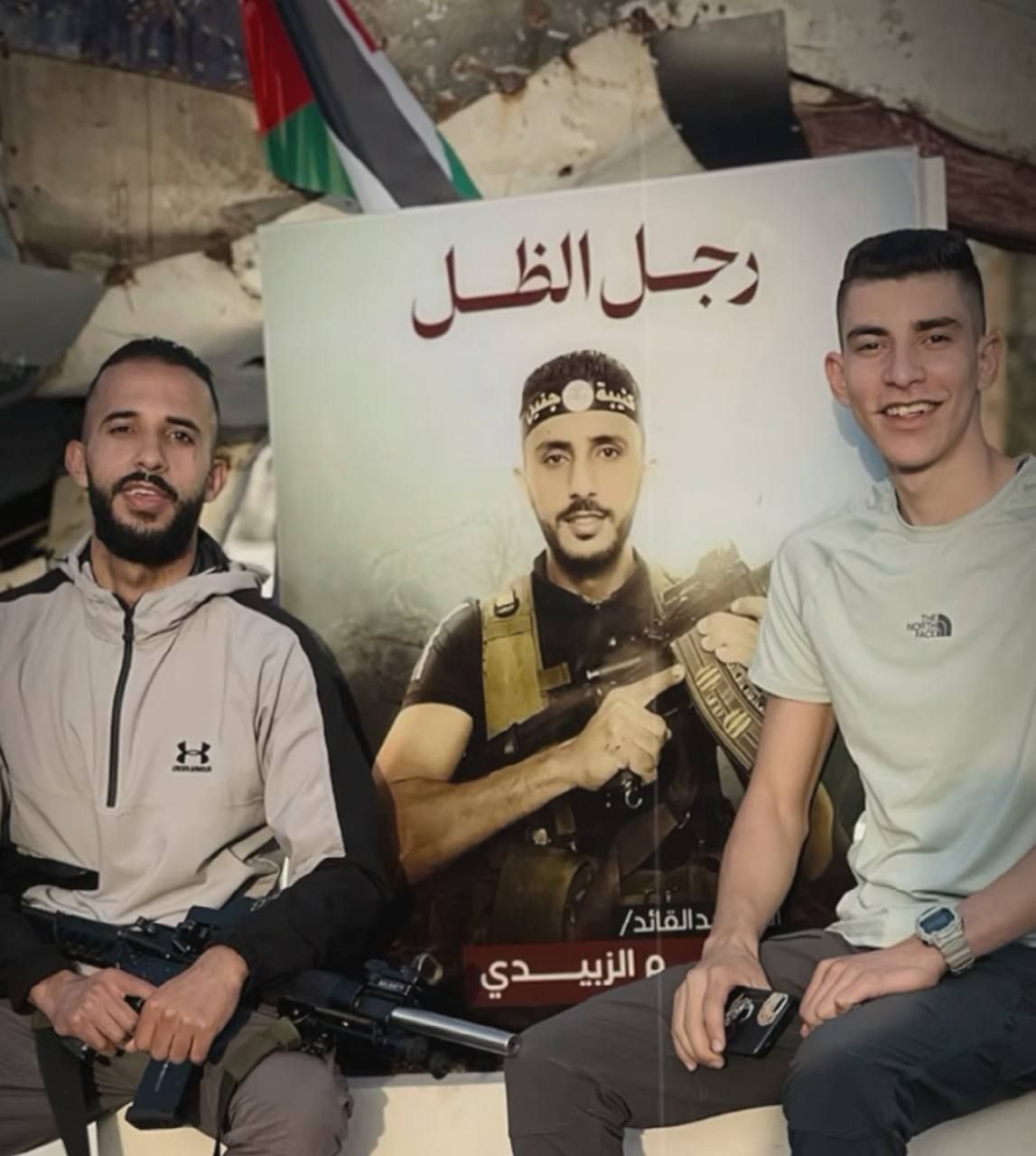
On 4 September 2024, two days before this anniversary, Zakaria’s eldest son Mohammed was martyred at the age of 21, a leader and a fighter in the resistance in Jenin, alongside four of his comrades, in a Zionist assassination attack which fired three missiles at their car.
Mohammed Zubaidi carries the body of the martyr Wafa Jarrar.
Samidoun statements on the Freedom Tunnel
- “Freedom Tunnel” heroes sentenced to additional five years in occupation prisons after self-liberation
- The light of the Freedom Tunnel shines toward liberation
- Freedom Tunnel prisoners recount their drive for liberation: Organize to support the Palestinian prisoners
- The resistance continues: Prisoners announce new steps of struggle
- Liberation through the Freedom Tunnel: Stand with Palestinian Prisoners’ Uprising
- Developing news: Six Palestinian political prisoners liberate themselves from colonial Israeli prison
Discover more from Samidoun: Palestinian Prisoner Solidarity Network
Subscribe to get the latest posts sent to your email.

